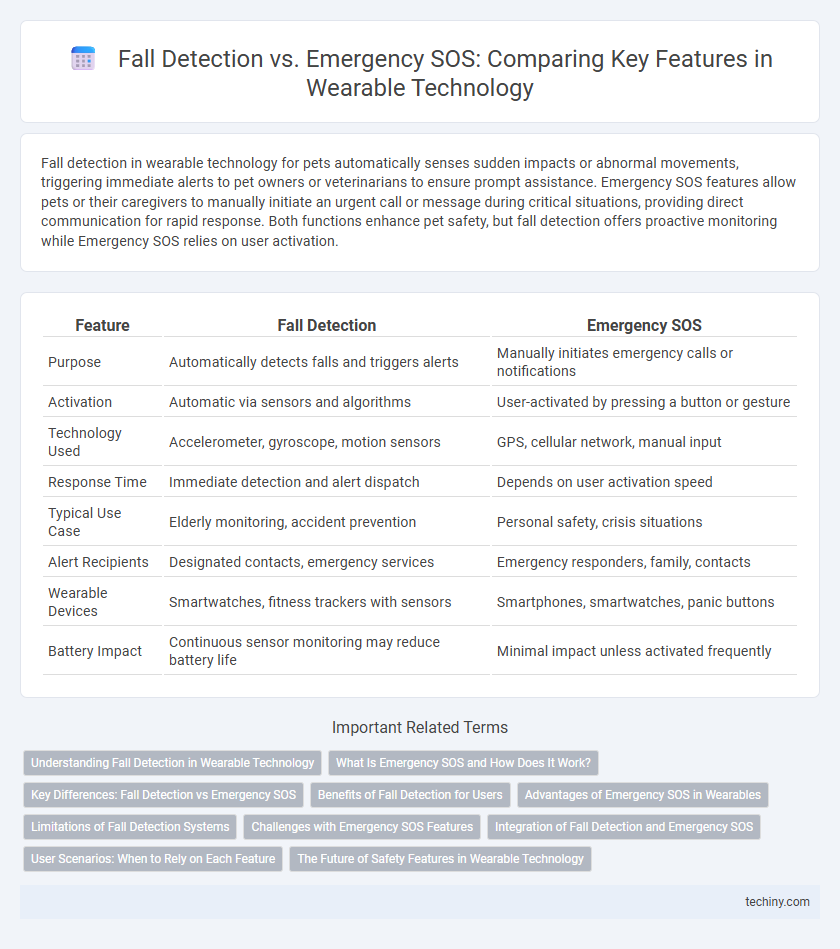Fall detection in wearable technology for pets automatically senses sudden impacts or abnormal movements, triggering immediate alerts to pet owners or veterinarians to ensure prompt assistance. Emergency SOS features allow pets or their caregivers to manually initiate an urgent call or message during critical situations, providing direct communication for rapid response. Both functions enhance pet safety, but fall detection offers proactive monitoring while Emergency SOS relies on user activation.
Table of Comparison
| Feature | Fall Detection | Emergency SOS |
|---|---|---|
| Purpose | Automatically detects falls and triggers alerts | Manually initiates emergency calls or notifications |
| Activation | Automatic via sensors and algorithms | User-activated by pressing a button or gesture |
| Technology Used | Accelerometer, gyroscope, motion sensors | GPS, cellular network, manual input |
| Response Time | Immediate detection and alert dispatch | Depends on user activation speed |
| Typical Use Case | Elderly monitoring, accident prevention | Personal safety, crisis situations |
| Alert Recipients | Designated contacts, emergency services | Emergency responders, family, contacts |
| Wearable Devices | Smartwatches, fitness trackers with sensors | Smartphones, smartwatches, panic buttons |
| Battery Impact | Continuous sensor monitoring may reduce battery life | Minimal impact unless activated frequently |
Understanding Fall Detection in Wearable Technology
Fall detection in wearable technology utilizes advanced sensors such as accelerometers and gyroscopes to accurately identify sudden movements or impacts indicating a fall. These devices automatically trigger alerts to emergency contacts or services, reducing response times and potentially saving lives. Unlike Emergency SOS, which requires manual activation, fall detection offers proactive safety by continuously monitoring the wearer's activity for unintentional falls.
What Is Emergency SOS and How Does It Work?
Emergency SOS is a critical feature in wearable technology designed to quickly alert emergency services and designated contacts during urgent situations. By pressing and holding specific buttons or using voice commands, the device automatically sends location data and distress signals through cellular or paired smartphone connections. This technology enhances personal safety by ensuring immediate assistance without requiring detailed user input during emergencies.
Key Differences: Fall Detection vs Emergency SOS
Fall Detection in wearable technology automatically senses sudden impacts or rapid changes in movement, triggering an alert to emergency contacts without user input. Emergency SOS requires manual activation, enabling users to quickly send distress signals and location information to emergency services. While Fall Detection offers proactive safety monitoring, Emergency SOS provides user-controlled assistance for a wider range of emergencies.
Benefits of Fall Detection for Users
Fall detection technology in wearable devices provides immediate alerts to emergency contacts or services when a sudden fall is detected, significantly reducing response times and improving user safety. Unlike Emergency SOS, which relies on manual activation, fall detection automatically triggers assistance, benefiting elderly users and individuals with mobility challenges by ensuring help arrives even if they are unconscious or immobile. This proactive safety feature enhances independence and peace of mind for both users and caregivers.
Advantages of Emergency SOS in Wearables
Emergency SOS in wearable technology offers rapid and direct communication with emergency services, ensuring immediate assistance during critical situations. This feature allows users to manually trigger alerts, providing precise location data and contact details, which enhances response accuracy. Unlike fall detection, which relies on sensors and may miss non-fall emergencies, Emergency SOS gives users full control to signal help whenever necessary, improving overall safety and reliability.
Limitations of Fall Detection Systems
Fall detection systems in wearable technology often struggle with false alarms due to sudden movements that mimic falls, reducing their reliability. These systems may fail to detect all types of falls, especially slow or gradual collapses, limiting their effectiveness in emergency situations. Battery life constraints and sensor sensitivity also impact continuous monitoring capabilities and the timely activation of emergency SOS alerts.
Challenges with Emergency SOS Features
Emergency SOS features in wearable technology often face challenges such as delayed response times due to connectivity issues and false alarms triggered by accidental activations. These limitations can hinder timely assistance during genuine emergencies, reducing the reliability of SOS alerts compared to dedicated fall detection systems. Enhancing sensor accuracy and network dependability remains crucial for improving the effectiveness of emergency SOS functionalities.
Integration of Fall Detection and Emergency SOS
Integrating fall detection with Emergency SOS in wearable technology creates a comprehensive safety system that automatically detects falls and immediately alerts emergency contacts or services. This synergy leverages advanced sensors and GPS data to provide timely assistance, minimizing response time during critical incidents. Combining these features enhances user safety by offering seamless monitoring and rapid emergency support in one device.
User Scenarios: When to Rely on Each Feature
Fall detection is essential for users prone to sudden falls due to medical conditions or elderly individuals living alone, automatically triggering alerts when a hard impact is detected. Emergency SOS is best suited for situations requiring immediate human intervention beyond falls, such as accidents, health crises, or personal safety threats, allowing users to manually summon help. Choosing between these features depends on the likelihood of falls versus other emergencies and the user's ability to initiate alerts independently.
The Future of Safety Features in Wearable Technology
Wearable technology is evolving to integrate advanced fall detection systems that use AI-powered sensors to accurately identify irregular movements and alert emergency contacts instantly. Emergency SOS features are becoming more sophisticated with real-time GPS tracking and automatic incident reporting, enhancing response times and user safety. Future developments will likely combine predictive analytics and biometric monitoring to proactively prevent emergencies and provide comprehensive health insights.
Fall Detection vs Emergency SOS Infographic

 techiny.com
techiny.com